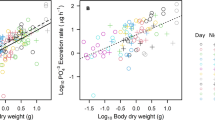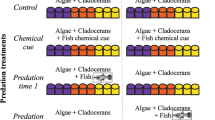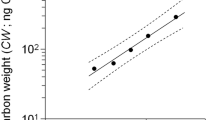Abstract
Our study used a metabolic theory of ecology (MTE) to explore scaling of metabolic rates by body size and temperature, and to predict nutrient excretion by common carp (Cyprinus carpio). At high biomasses, common carp have negative impacts on water quality, and one mechanism is excretion of the nutrients N and P. We measured whole-body and mass-specific excretion rates during summer and winter for fish of different sizes (wet mass range 28–1,196 g) to produce an allometric scaling model capable of predicting excretion at different temperatures. We found positive relationships between both dissolved and total nutrient concentrations and fish wet mass in summer and winter, with greater excretion rates in summer (mean water temperature 24.2°C) than in winter (mean water temperature 9.2°C). Mass-specific excretion rates decreased with increasing fish size, consistent with the MTE, and the temperature-adjusted model explained more variation for N excretion than for P. The proportion of dissolved nutrients (NH4 and PO4) to total nutrients increased with increasing fish size. The significance of these models is that they can be used to predict population-based nutrient excretion by common carp when thermal history, fish density and size distribution in a water body are known.




Similar content being viewed by others
References
APHA, 1998. Standard methods for the examination of water and wastewater, 20th ed. American Public Health Association, Washington, DC.
Bajer, P. G., G. Sullivan & P. W. Sorensen, 2009. Effects of a rapidly increasing population of common carp on vegetation cover and waterfowl in a recently restored midwestern shallow lake. Hydrobiologia 632: 235–245.
Brown, J. H. & J. F. Gillooly, 2003. Ecological food webs: high-quality data facilitate theoretical unification. Proceedings of the National Academy of Sciences of the United States of America 100: 1467–1468.
Brown, J. H., J. F. Gillooly, A. P. Allen, V. M. Savage & G. B. West, 2004. Towards a metabolic theory of ecology. Ecology 85: 1771–1789.
Brown, J. H., A. P. Allen & J. F. Ginooly, 2007. The metabolic theory of ecology and the role of body size in marine and freshwater ecosystems. In Hildrew, A. G., D. G. Raffaelli & R. Edmonds-Brown (eds), Body size the structure and function of aquatic ecosystems. Cambridge University Press, Cambridge: 1–15.
Daniel, A. J., B. J. Hicks, N. Ling & B. O. David, 2011. Movements of radio- and acoustic-tagged adult koi carp in the Waikato River, New Zealand. North American Journal of Fisheries Management 31: 352–362.
Driver, P. D., G. P. Closs & T. Koen, 2005. The effects of size and density of carp (Cyprinus carpio L.) on water quality in an experimental pond. Fundamental and Applied Limnology 163: 117–131.
Ebina, J., T. Tsuyoshi & T. Shirai, 1983. Simultaneous determination of total nitrogen and total phosphorus in water using peroxodisulfate oxidation. Water Research 17: 1721–1726.
Gehrke, P. C. & J. H. Harris, 1994. The role of fish in cyanobacterial blooms in Australia. Marine and Freshwater Research 45: 905–915.
Gilligan, D. & T. Rayner, 2007. The distribution, spread, ecological impacts and potential control of carp in the upper Murray River. In NSW Department of Primary Industries, Fisheries Research Report Series: No. 14. NSW Department of Primary Industries, Cronulla, New South Wales, Australia.
Gillooly, J. F., J. H. Brown, G. B. West, V. M. Savage & E. L. Charnov, 2001. Effects of size and temperature on metabolic rate. Science 293: 2248–2251.
Grimm, N., 1988. Feeding dynamics, nitrogen budgets, and ecosystem role of a desert stream omnivore (Agosia chrysogaster) (Pisces: Cyprinidae). Environmental Biology of Fishes 21: 143–152.
Hall, R. O., B. J. Koch, M. C. Marshall, B. W. Taylor & L. M. Tronstad, 2007. How body size mediates the role of animals in nutrient cycling in aquatic ecosystems. In Hildrew, A. G., D. G. Raffaelli & R. Edmonds-Brown (eds), Body size the structure and function of aquatic ecosystems. Cambridge University Press, Cambridge: 286–305.
Harris, J. H. & P. E. Gehrke, 1997. Fish and rivers in stress: the NSW river survey. New South Wales Fisheries Office of Conservation and the Cooperative Research Centre for Freshwater Ecology, Sydney.
Hicks, B. J., N. Ling & M. W. Osborne, 2006. Quantitative estimates of fish abundance from boat electrofishing. In: Phelan, M.J. & H. Bajhau (eds), A guide to monitoring fish stocks and aquatic ecosystems, Australian Society for Fish Biology workshop proceedings, Darwin, Northern Territory, 11-15 July 2005. Fisheries Incidental Publication No. 25. Northern Territory Department of Primary Industry, Fisheries, and Mines, Darwin: 104–111.
Hicks, B. J., N. Ling, & A. J. Daniel, 2011. Common carp (Cyprinus carpio). In A Handbook of Global Freshwater Invasive Species. Earthscan, London: 247–260.
Huxley, J. S., 1932. Problems of Relative Growth. Methuen, London.
King, A. J., A. I. Robertson & M. R. Healey, 1997. Experimental manipulations of the biomass of introduced carp (Cyprinus carpio) in billabongs. I. Impacts on water-column properties. Marine and Freshwater Research 48: 435–443.
Kleiber, M., 1932. Body size and metabolism. Hilgardia 6: 315–332.
Koehn, J. D., 2004. Carp (Cyprinus carpio) as a powerful invader in Australian waterways. Freshwater Biology 49: 882–894.
Lamarra, V. A., 1975. Digestive activities of carp as a major contributor to the nutrient loading of lakes. Verhandlungen des Internationalen Verein Limnologie 19: 2461–2468.
Matsuzaki, S. S., N. Usio, N. Takamura & I. Washitani, 2007. Effects of common carp on nutrient dynamics and littoral community composition: roles of excretion and bioturbation. Fundamental and Applied Limnology 168: 27–38.
McDowall, R. M., 1990. New Zealand Freshwater Fish: A Guide and Natural History. Heinemann Reed, Auckland.
McIntyre, P. B., A. S. Flecker, M. J. Vanni, J. M. Hood, B. W. Taylor & S. A. Thomas, 2008. Fish distributions and nutrient cycling in streams: can fish create biogeochemical hotspots? Ecology 89: 2335–2346.
Mehner, T., J. Ihlau, H. Dãrner & F. Hãlker, 2005. Can feeding of fish on terrestrial insects subsidize the nutrient pool of lakes? Limnology and Oceanography 50: 2022–2031.
Ohlberger, J., Ø. Y. Langangen, E. Edeline, D. Claessen, I. J. Winfield, N. C. Stenseth & L. A. Vøllestad, 2011. Stage-specific biomass overcompensation by juveniles in response to increased adult mortality in a wild fish population. Ecology 92: 2175–2182.
Padisãk, J. & C. S. Reynolds, 2003. Shallow lakes: the absolute, the relative, the functional and the pragmatic. Hydrobiologia 506–509: 1–11.
Persson, A., 1997. Phosphorus release by fish in relation to external and internal load in a eutrophic lake. Limnology and Oceanography 42: 577–583.
Peters, R. H.,1983. The Ecological Implications of Body Size. Cambridge University Press, New York.
Post, D. M. & A. W. Walters, 2009. Nutrient excretion rates of anadromous alewives during their spawning migration. Transactions of the American Fisheries Society 138: 264–268.
Roberts, J., A. Chick, L. Oswald & P. Thompson, 1995. Effect of carp, Cyprinus carpio L., an exotic benthivorous fish, on aquatic plants and water quality in experimental ponds. Marine and Freshwater Research 46: 1171–1180.
Rowe, D. K., 2007. Exotic fish introductions and the decline of water clarity in small North Island, New Zealand lakes: a multi-species problem. Hydrobiologia 583: 345–358.
Savage, V. M., J. F. Gillooly, W. H. Woodruff, G. B. West, A. P. Allen, B. J. Enquist & J. H. Brown, 2004. The predominance of quarter-power scaling in biology. Functional Ecology 18: 257–282.
Schaus, M. H., M. J. Vanni, T. E. Wissing, M. T. Bremigan, J. E. Garvey & R. A. Stein, 1997. Nitrogen and phosphorus excretion by detritivorous gizzard shad in a reservoir ecosystem. Limnology and Oceanography 42: 1386–1397.
Schindler, D. W., 1974. Eutrophication and recovery in experimental lakes: implications for lake management. Science 184: 897–899.
Schlosser, I. J. & P. L. Angermeier, 1995. Spatial variation in demographic processes of lotic fishes: conceptual models, empirical evidence, and implications for conservation. American Fisheries Society Symposium 17: 392–401.
Shostell, J. & P. A. Bukaveckas, 2004. Seasonal and interannual variation in nutrient fluxes from tributary inputs, consumer recycling and algal growth in a eutrophic river impoundment. Aquatic Ecology 38: 359–373.
Thompson, D. W., 1917. On Growth and Form. Cambridge University Press, Cambridge.
Thwaites, L. A., B. B. Smith, M. Decelis, D. Fleer & A. Conallin, 2010. A novel push trap element to manage carp (Cyprinus carpio L.): a laboratory trial. Marine and Freshwater Research 61: 42–48.
Torres, L. E. & M. J. Vanni, 2007. Stoichiometry of nutrient excretion by fish: interspecific variation in a hypereutrophic lake. Oikos 116: 259–270.
Vanni, M. J., 2002. Nutrient cycling by animals in freshwater ecosystems. Annual Review of Ecology and Systematics 33: 341–370.
Williams, A. E., B. Moss & J. Eaton, 2002. Fish induced macrophyte loss in shallow lakes: top–down and bottom–up processes in mesocosm experiments. Freshwater Biology 47: 2216–2232.
Zimmer, K. D., B. R. Herwig & L. M. Laurich, 2006. Nutrient excretion by fish in wetland ecosystems and its potential to support algal production. Limnology and Oceanography 51: 197–207.
Acknowledgments
We thank the following people from the Department of Biological Sciences, University of Waikato: Jonathan Banks, Dudley Bell, Jeroen Brijs, Brennan Mahoney, Warrick Powrie, Ray Tana and Grant Tempero for field assistance, and David Hamilton for editorial advice. Lyn Hunt (Department of Statistics, University of Waikato) provided mathematical advice. We especially thank Louise Stewart for conducting nutrient analyses. This work was funded by a New Zealand Ministry of Business, Innovation and Employment contract: UOWX0505. All aspects of the study were approved by the University of Waikato Animal Ethics Committee (Protocol 769).
Author information
Authors and Affiliations
Corresponding author
Additional information
Handling editor: M. Power
Electronic supplementary material
Below is the link to the electronic supplementary material.
Appendix 1
Raw data including tank temperature, fish wet mass, and per capita and mass-dependent carp excretion rates for summer and winter experiments. − indicates that data are not available at that point (see Methods). (DOCX 20 kb)
Rights and permissions
About this article
Cite this article
Morgan, D.K.J., Hicks, B.J. A metabolic theory of ecology applied to temperature and mass dependence of N and P excretion by common carp. Hydrobiologia 705, 135–145 (2013). https://doi.org/10.1007/s10750-012-1388-2
Received:
Revised:
Accepted:
Published:
Issue Date:
DOI: https://doi.org/10.1007/s10750-012-1388-2




